Differential effects of abnormal tactile experience on shaping representation patterns in developing and adult motor cortex
- PMID: 9364069
- PMCID: PMC6573625
- DOI: 10.1523/JNEUROSCI.17-23-09220.1997
Differential effects of abnormal tactile experience on shaping representation patterns in developing and adult motor cortex
Abstract
This study investigates the influence of early somatosensory experience on shaping movement representation patterns in motor cortex. Electrical microstimulation was used to map bilaterally the motor cortices of adult rats subjected to altered tactile experience by unilateral vibrissa trimming from birth (birth-trimmed group) or for comparable periods that began in adulthood (adult-trimmed group). Findings demonstrated that (1) vibrissa trimming from birth, but not when initiated in adulthood, led to a significantly smaller-sized primary motor cortex (M1) vibrissa representation in the hemisphere contralateral to the trimmed vibrissae, with no evidence for concomitant changes in size of the adjacent forelimb representation or the representation of the intact vibrissae in the opposite (ipsilateral) hemisphere; (2) in the contralateral hemispheres of the birth-trimmed group, an abnormal pattern of evoked vibrissa movement was evident in which bilateral or ipsilateral (intact) vibrissa movement predominated; (3) in both hemispheres of the birth-trimmed group, current thresholds for eliciting movement of the trimmed vibrissa were significantly lower than normal; and (4) in the adult-trimmed group, but not in the birth-trimmed group, there was a decrease bilaterally in the relative frequency of dual forelimb-vibrissa sites that form the common border between these representations. These results show that sensory experience early in life exerts a significant influence in sculpting motor representation patterns in M1. The mature motor cortex is more resistant to the type and magnitude of influence that tactile experience has on developing M1, which may indicate that such an influence is constrained by a developmentally regulated critical period.
Figures







Similar articles
-
Changes in motor representation related to facial nerve damage and regeneration in adult rats.Exp Brain Res. 2000 Nov;135(1):53-65. doi: 10.1007/s002210000503. Exp Brain Res. 2000. PMID: 11104127
-
Time course of motor cortex reorganization following botulinum toxin injection into the vibrissal pad of the adult rat.Eur J Neurosci. 2002 Oct;16(7):1333-48. doi: 10.1046/j.1460-9568.2002.02195.x. Eur J Neurosci. 2002. PMID: 12405994
-
Organization of adult motor cortex representation patterns following neonatal forelimb nerve injury in rats.J Neurosci. 1988 Sep;8(9):3221-32. doi: 10.1523/JNEUROSCI.08-09-03221.1988. J Neurosci. 1988. PMID: 3171676 Free PMC article.
-
Anatomical loops and their electrical dynamics in relation to whisking by rat.Somatosens Mot Res. 1999;16(2):69-88. doi: 10.1080/08990229970528. Somatosens Mot Res. 1999. PMID: 10449057 Review.
-
Neuronal basis for object location in the vibrissa scanning sensorimotor system.Neuron. 2011 Nov 3;72(3):455-68. doi: 10.1016/j.neuron.2011.10.009. Neuron. 2011. PMID: 22078505 Free PMC article. Review.
Cited by
-
Sensory deprivation alters aggrecan and perineuronal net expression in the mouse barrel cortex.J Neurosci. 2007 May 16;27(20):5405-13. doi: 10.1523/JNEUROSCI.5425-06.2007. J Neurosci. 2007. PMID: 17507562 Free PMC article.
-
Short-term reorganization of input-deprived motor vibrissae representation following motor disconnection in adult rats.J Physiol. 2006 Jul 15;574(Pt 2):457-76. doi: 10.1113/jphysiol.2006.109116. Epub 2006 May 11. J Physiol. 2006. PMID: 16690708 Free PMC article.
-
Impaired activity-dependent neural circuit assembly and refinement in autism spectrum disorder genetic models.Front Cell Neurosci. 2014 Feb 7;8:30. doi: 10.3389/fncel.2014.00030. eCollection 2014. Front Cell Neurosci. 2014. PMID: 24570656 Free PMC article. Review.
-
Spontaneous Up states in vitro: a single-metric index of the functional maturation and regional differentiation of the cerebral cortex.Front Neural Circuits. 2015 Oct 13;9:59. doi: 10.3389/fncir.2015.00059. eCollection 2015. Front Neural Circuits. 2015. PMID: 26528142 Free PMC article.
-
Motor Evoked Potentials as Potential Biomarkers of Early Atypical Corticospinal Tract Development in Infants with Perinatal Stroke.J Clin Med. 2019 Aug 13;8(8):1208. doi: 10.3390/jcm8081208. J Clin Med. 2019. PMID: 31412592 Free PMC article.
References
-
- Akhtar ND, Land PW. Activity-dependent regulation of glutamic acid decarboxylase in the rat barrel cortex: effects of neonatal versus adult sensory deprivation. J Comp Neurol. 1991;307:200–213. - PubMed
-
- Antonini A, Stryker MP. Rapid remodeling of axonal arbors in the visual cortex. Science. 1993;260:1819–1821. - PubMed
-
- Asanuma H, Arnold AP. Noxious effects of excessive currents used for intracortical microstimulation. Brain Res. 1975;96:103–107. - PubMed
-
- Asanuma H, Arnold AP, Zarzecki P. Further study on the excitation of pyramidal tract cells by intracortical microstimulation. Exp Brain Res. 1976;26:443–462. - PubMed
-
- Baddeley AJ, Gundersen HJG, Cruz-Orive LM. Estimation of surface area from vertical sections. J Microsc. 1986;142:259–276. - PubMed
Publication types
MeSH terms
LinkOut - more resources
Full Text Sources
